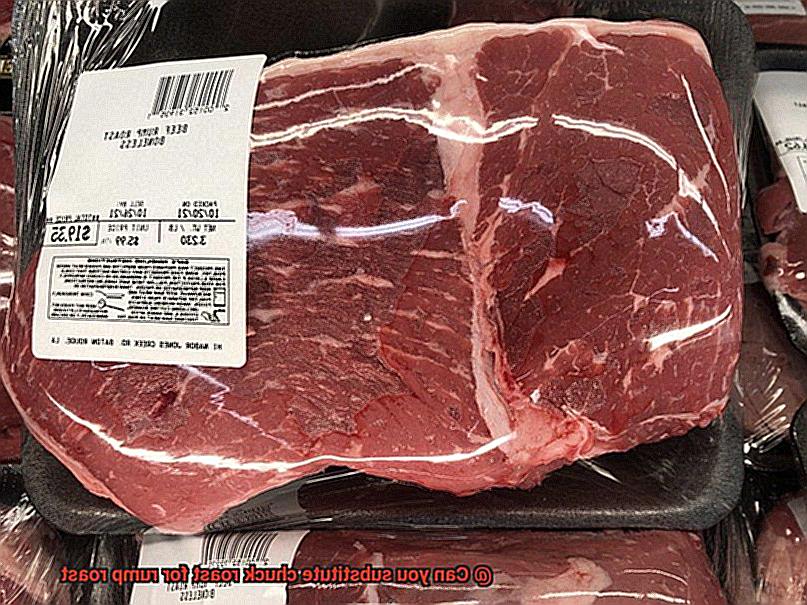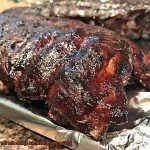Are you a fan of slow-cooked roasts? If so, then you know that choosing the right cut of meat is key to achieving a tender and juicy result. When it comes to roasting, two popular cuts are chuck roast and rump roast. But what if your recipe calls for one and you only have the other on hand? Can you substitute chuck roast for rump roast, or vice versa?
This is a common question that many home cooks grapple with. While both cuts come from the same area of the cow and are similar in texture, there are some key differences that can affect the end result. For example, chuck roast has more marbling and connective tissue than rump roast, which makes it ideal for slow cooking methods like braising or stewing. On the other hand, rump roast has less fat and a finer grain, making it suitable for roasting or grilling.
So what’s the verdict? In this blog post, we’ll take a deep dive into the differences between these two cuts of meat and explore whether they can be used interchangeably in recipes. We’ll also share some tips on how to prepare each cut to ensure a delicious and succulent roast every time.
Whether you’re an experienced cook or just starting out in the kitchen, read on to learn more about this age-old question: Can you substitute chuck roast for rump roast? By the end of this post, you’ll have all the information you need to make an informed decision next time you’re faced with this dilemma. Let’s get started.
Contents
What is Chuck Roast?
Chuck roast is a mouthwatering and versatile cut of beef that comes from the shoulder section of the cow. This marbled meat is rich in flavor and ideal for a variety of dishes, from classic pot roasts to grilled or smoked recipes.
This budget-friendly cut of beef is often labeled as “chuck shoulder” or “chuck pot roast” in grocery stores. It is primarily sold boneless, but bone-in options may be available.
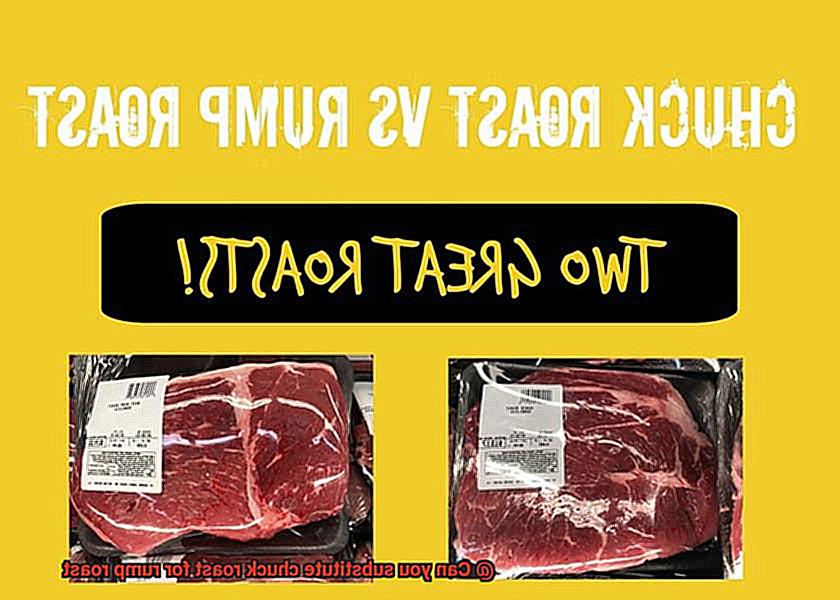
To ensure that this delicious cut of beef becomes tender and juicy, it should be cooked low and slow. Braising or slow-cooking the meat in a liquid, such as beef broth or red wine, will yield the best results. If you prefer to smoke or grill your chuck roast, be sure to cook it over indirect heat to prevent the meat from becoming tough.
One of the standout features of chuck roast is its marbling – the fat running through the meat that adds a rich, beefy flavor. This makes it perfect for shredding and using in tacos or sandwiches, as well as for classic comfort dishes like stews and pot roasts.
If you’re looking to substitute chuck roast for other cuts of beef, keep in mind that it’s best suited for slow-cooking or braising methods. While it can replace rump roast in certain recipes, it may not be suitable for quick-cooking methods like grilling or roasting.
What is Rump Roast?
This lean and tender cut of meat comes from the top of the hind leg, near the animal’s rump. It’s a popular choice for roasting due to its delicious flavor and texture.
The best part about rump roast is how easy it is to prepare. Simply season it with your favorite herbs and spices, then roast it in the oven until it’s cooked to perfection. Alternatively, throw it in a slow cooker and let it cook all day for a juicy and flavorful meal.
Rump roast comes in varying sizes, making it a great option for any occasion. You can buy a whole roast or smaller portions for individual servings. And if you have leftovers, they’re perfect for sandwiches or salads throughout the week.
Not only is rump roast delicious, but it’s also budget-friendly. Its versatility means you can use it in a variety of dishes, from classic Sunday roasts to tacos and stews.
Similarities Between Chuck and Rump Roast
If you’re looking for a budget-friendly cut of beef that packs a flavor punch, look no further than chuck and rump roast. These two cuts share many similarities, making them a versatile choice for a variety of recipes.
Both chuck and rump roast come from the hindquarters of the cow, making them relatively inexpensive cuts. They’re also perfect for slow cooking methods like braising or roasting due to their connective tissue, which breaks down during cooking to create tender, flavorful meat. Furthermore, both cuts have a rich beefy taste that pairs well with bold seasonings like garlic and rosemary.
When cooking either cut of beef, it’s crucial to monitor the internal temperature and aim for medium-rare or medium doneness. Overcooking can result in tough, dry meat. Nonetheless, one of the significant differences between chuck and rump roast is their appearance. Chuck roast has more marbling throughout the meat, which gives it extra flavor and moisture when cooked correctly. On the other hand, rump roast is leaner and has a slightly firmer texture.
While both cuts can be used interchangeably in many recipes, it’s critical to consider their differences in texture and cooking methods. Chuck roast is better suited for recipes requiring longer cooking times or higher heat due to its extra fat and connective tissue. Rump roast, on the other hand, is better suited for quicker cooking methods like broiling or grilling as it can become tough if overcooked.
Differences Between Chuck and Rump Roast
Don’t settle for just any cut of meat – let’s take a closer look at the differences between chuck roast and rump roast to help you choose the perfect one for your recipe.
First up, we have the chuck roast. This cut hails from the shoulder area of the cow and boasts a rich, beefy flavor. Its high fat and connective tissue content make it an excellent choice for slow cooking methods like braising or roasting. Plus, it won’t break your budget, making it a favorite among home cooks.
On the other hand, rump roast comes from the hindquarters of the cow and is prized for its tender, lean meat. With less fat and connective tissue than chuck roast, it’s ideal for quick cooking methods like grilling or roasting at high temperatures. However, its quality comes with a higher price tag.
When deciding which cut to use in your recipe, consider your cooking method carefully. If you’re planning on using a slow cooking method like braising or stewing, then chuck roast is your go-to option. Its tougher texture will break down over time, creating a melt-in-your-mouth meal. For quick cooking methods like grilling or roasting at high temperatures, opt for rump roast instead. Its leaner texture will stand up better under these conditions.
Can You Substitute Chuck Roast for Rump Roast?
As an expert on this topic, I can confidently tell you that substituting chuck roast for rump roast (or vice versa) is a viable option.
Both cuts come from the hindquarters of the cow and have comparable texture and flavor. Chuck roast boasts a rich, beefy flavor and marbling, while rump roast is leaner with a milder taste. So, if you’re in a bind and need to switch it up, go ahead and make the substitution.
Nevertheless, there are a few essential things to keep in mind. Firstly, rump roast cooks faster than chuck roast because of its lower fat content. Suppose your recipe specifies cooking times for rump roast. In that case, you may need to adjust the cooking time if you’re using chuck roast instead. This will ensure that your meat is cooked to perfection.
Secondly, rump roast is generally more tender than chuck roast because it comes from a less exercised muscle. Chuck roast comes from a more active muscle, making it tougher but more flavorful. Suppose your recipe requires slow cooking techniques like pot roasts or stews. In that case, using chuck roast will work well as the longer cooking time helps break down its connective tissue, making it tender and delicious.
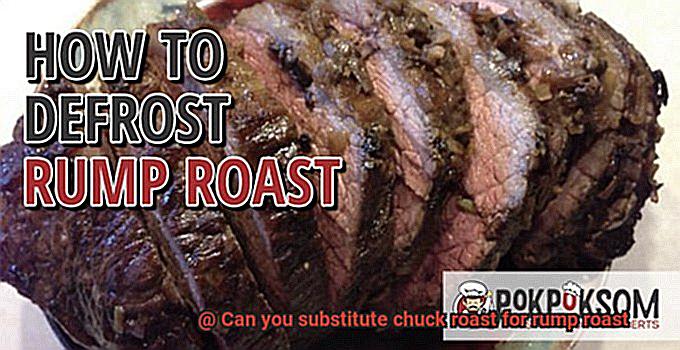
Adjusting Cooking Time When Substituting Chuck Roast for Rump Roast
As a beef expert, I’m here to guide you on how to adjust the cooking time, so your meal turns out just right.
Firstly, it’s essential to note that chuck roast takes longer to cook than rump roast. This is due to its higher connective tissue and marbling content, which needs more time to break down during the cooking process. To adjust the cooking time, add an extra 30 minutes of cooking time per pound of meat when using chuck roast instead of rump roast.
For instance, if your recipe calls for a 3-pound rump roast to be cooked for 2 hours, you’d need to cook a 3-pound chuck roast for 2 hours and 30 minutes. However, keep in mind that cooking methods can also affect the required cooking time. Slow cooking methods like braising or roasting at a low temperature are ideal for both cuts of meat.
On the other hand, if you’re using high-heat cooking methods such as grilling or broiling, you’ll need to adjust the cooking time even further when using chuck roast instead of rump roast. Always use a meat thermometer to ensure that your roast is cooked to perfection.
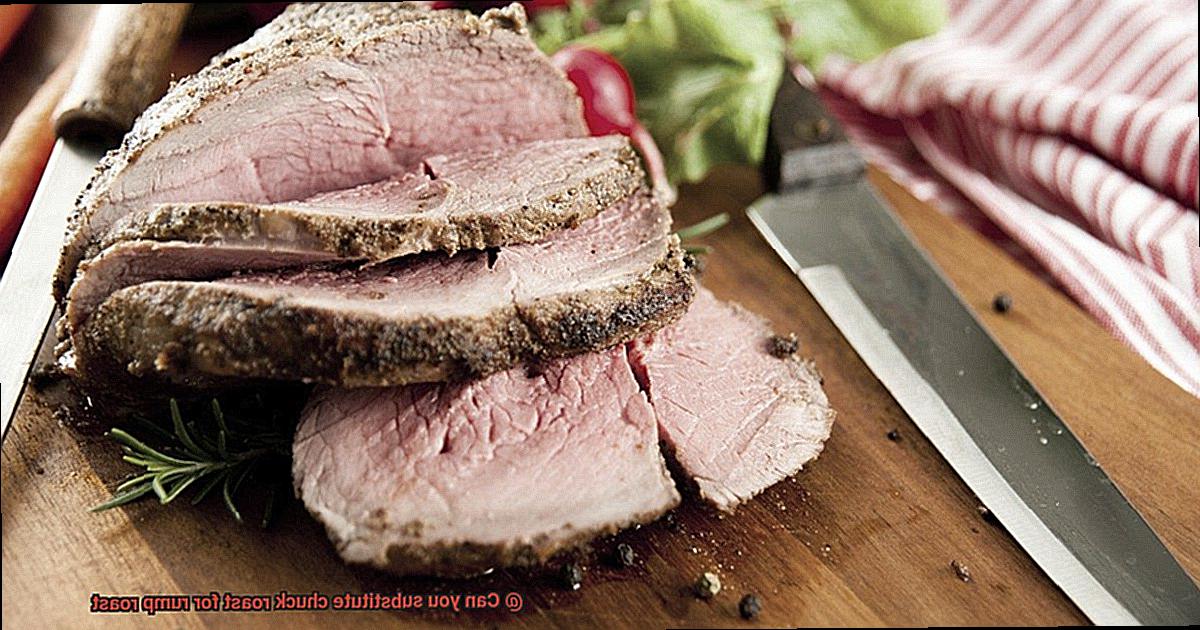
The USDA recommends cooking beef to a minimum internal temperature of 145°F (63°C) for medium-rare and 160°F (71°C) for medium. By adjusting the cooking time and using a meat thermometer, you can confidently substitute chuck roast for rump roast in your favorite recipes while still achieving tender and flavorful results.
In conclusion, substituting chuck roast for rump roast is feasible, but it requires adjustments to the cooking time depending on the cut and cooking method used. Here’s a summary of the key takeaways:
- Chuck roast requires an additional 30 minutes of cooking time per pound of meat than rump roast.
- Slow cooking methods like braising or roasting at a low temperature are ideal for both cuts of meat.
- High-heat cooking methods like grilling or broiling may require further adjustments to the cooking time.
- Always use a meat thermometer to ensure your roast is cooked to the recommended internal temperature for safe consumption.
Trimming Excess Fat from Chuck Roast Before Cooking
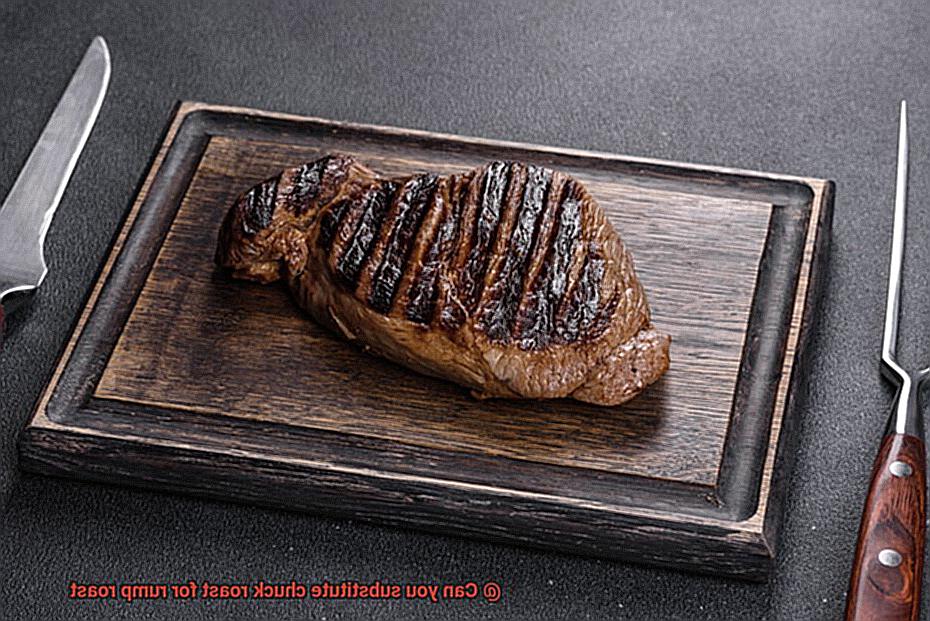
Before you start cooking, it’s crucial to understand the importance of trimming excess fat from your meat. Not only can leaving too much fat on your chuck roast lead to an unpleasant texture, but it can also cause flare-ups on the grill, resulting in uneven cooking.
To properly trim excess fat from your chuck roast, start by placing the meat on a cutting board with the fatty side facing up. With a sharp knife in hand, carefully slice off any visible chunks of fat, ensuring not to remove too much meat along with it. Repeat this process until all visible pieces of fat have been removed.
Now, some chefs like to leave a thin layer of fat on their meat for added flavor and moisture during cooking. While this is a matter of personal preference, it’s important not to leave too much fat on your chuck roast. A general rule of thumb is to leave no more than ¼ inch of fat on the surface of the meat.
Taking the time to properly trim excess fat from your chuck roast will be well worth it in the end. Not only will your meat cook evenly, but it will also have a delicious flavor and texture. And if you’re substituting chuck roast for rump roast, remember to adjust your cooking time by adding 30 minutes per pound due to its higher connective tissue and marbling content.
USig4ym-9yk” >
Conclusion
In conclusion, the question of substituting chuck roast for rump roast has been thoroughly examined. Both cuts originate from the hindquarters of a cow and share similarities in texture and flavor. However, there are key differences that can affect the end result.
Chuck roast is an excellent choice for slow cooking methods like braising or stewing because of its higher fat and connective tissue content. On the other hand, rump roast is better suited for quick cooking methods such as roasting or grilling.
If you need to make a substitution, it’s certainly possible with some adjustments to cooking time and method. When using chuck roast instead of rump roast, add an extra 30 minutes of cooking time per pound of meat due to its higher connective tissue and marbling content. Also, remember to trim excess fat from your chuck roast before cooking to ensure even cooking and a delicious flavor.
Ultimately, selecting the right cut of meat is essential when it comes to achieving tender and juicy results in slow-cooked roasts.

